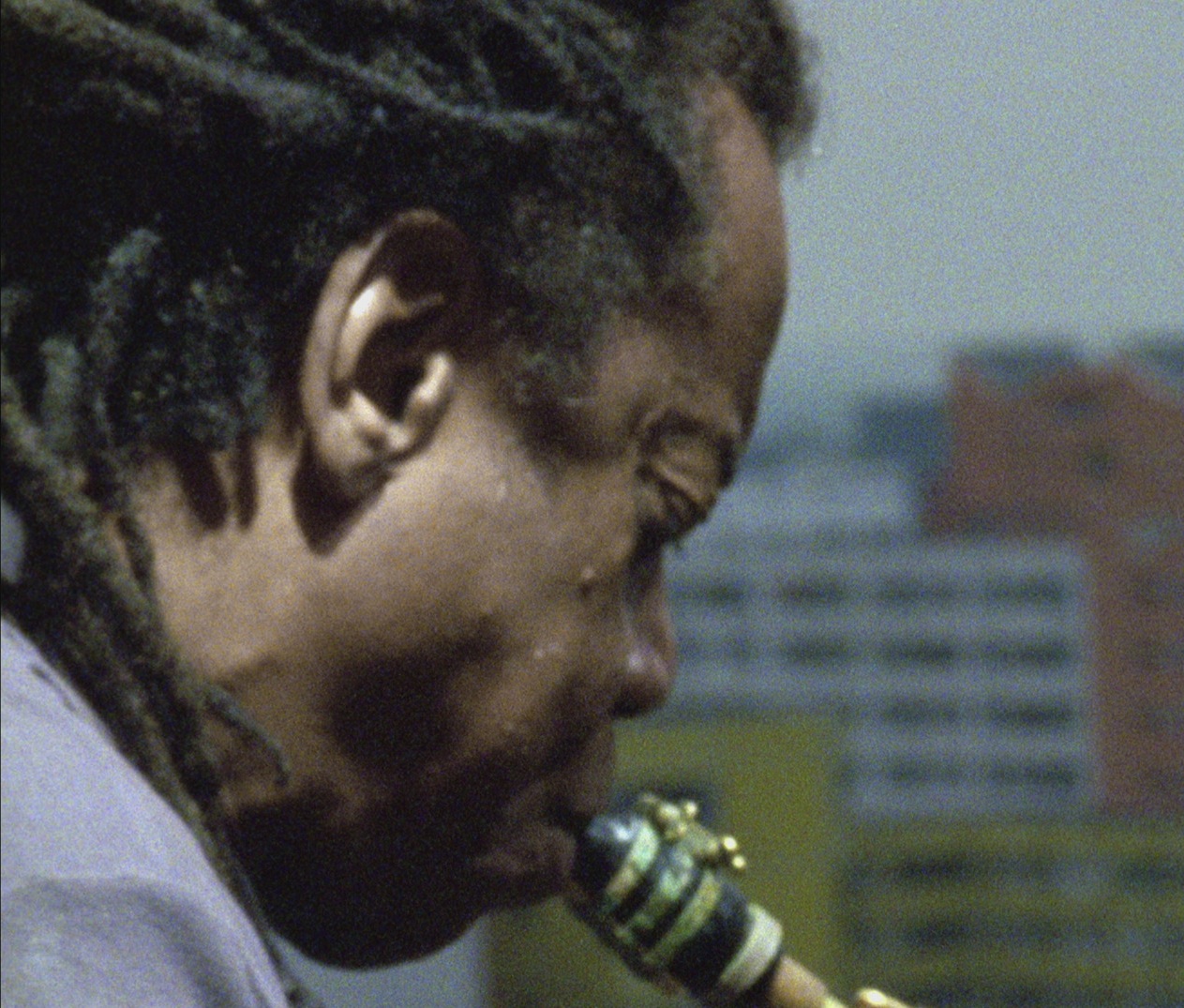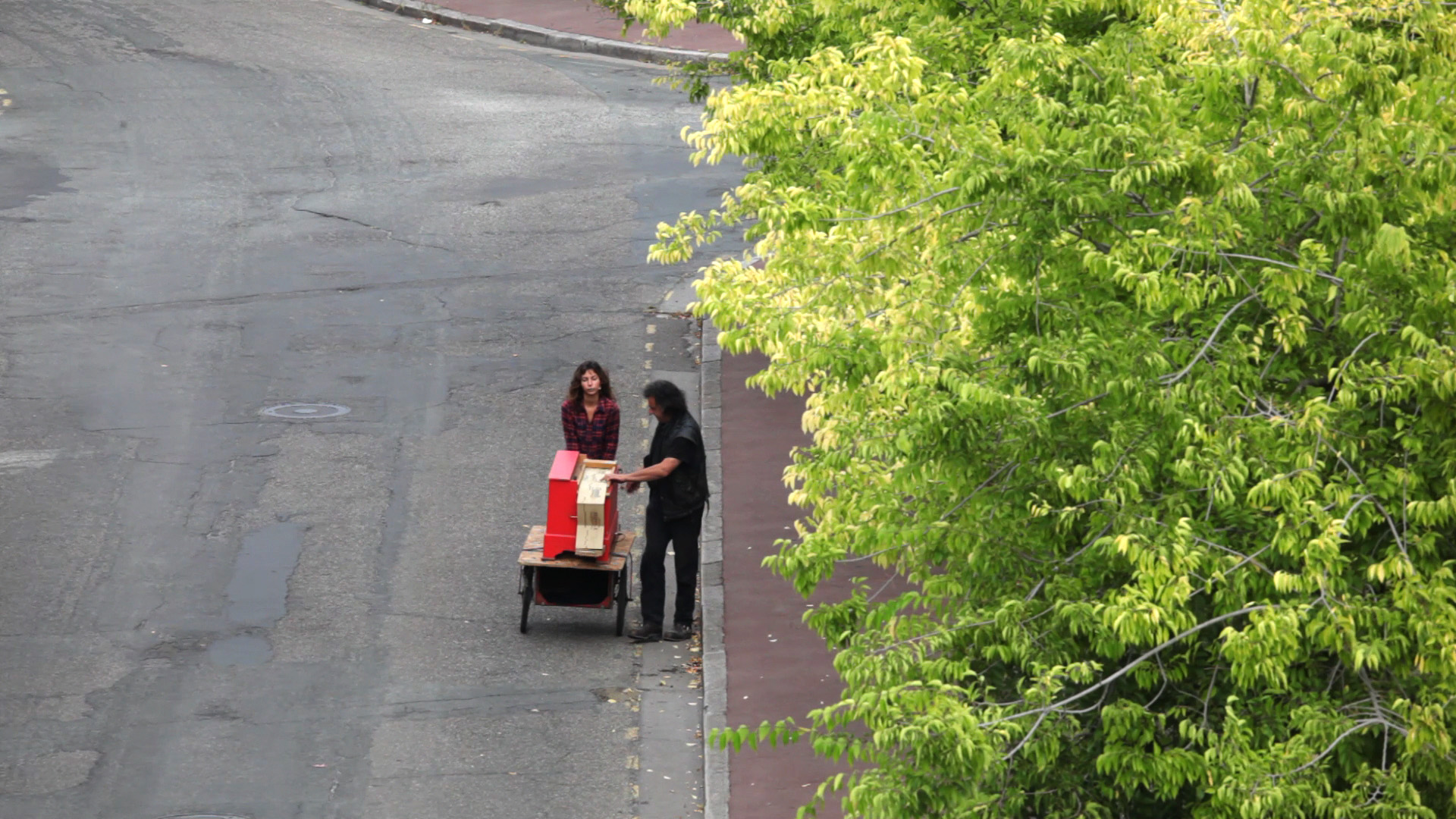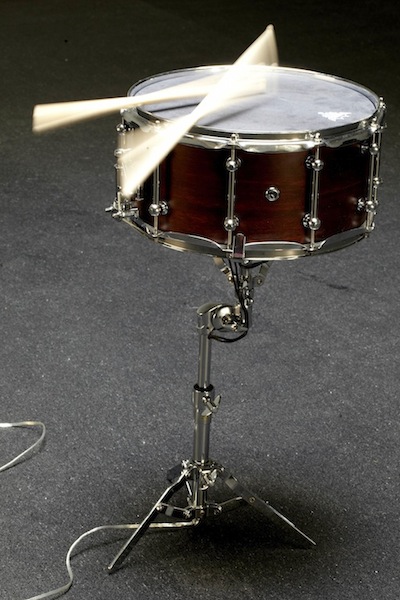Anri Sala, Serpentine Gallery | reviews, news & interviews
Anri Sala, Serpentine Gallery
Anri Sala, Serpentine Gallery
Sound and image take you on a journey through space and time

A single snare drum greets you on entry to the Serpentine Gallery; there’s no one playing it, yet in response to an inaudible cue, the drumsticks begin to vibrate autonomously. Meanwhile on a nearby wall, a pair of blue rubber gloves revolves slowly as if searching for something; every now and then they take on the shape of human hands, as though embodying the gestures of the absent drummer.
The various parts of Anri Sala’s installation are in continual dialogue with each other, and the uniting factor is sound. The ghostly drumsticks are activated by low frequency vibrations emanating from the video Answer Me (2008) being projected in the central gallery. The video was shot inside the geodesic domes of the Teufelsberg Intelligence Station in West Berlin, designed by Buckminster Fuller during the Cold War for surveillance purposes.
 Inside the abandoned building, a young man (pictured right) concentrates with superhuman intensity on the drums, which he is playing with enough vehemence to drown out the words of his female companion. The only phrases audible over the barrage of sound are “Answer me” and “It is over”; the last remark is made in the silence that follows the frenetic drumming, as though to announce the end of the relationship and the artwork in the same breath. But there’s one last shot that shows the building silhouetted against the Berlin sky; shaped like a prick and balls, the dilapidated structure seems emblematic of the tattered state of their affair.
Inside the abandoned building, a young man (pictured right) concentrates with superhuman intensity on the drums, which he is playing with enough vehemence to drown out the words of his female companion. The only phrases audible over the barrage of sound are “Answer me” and “It is over”; the last remark is made in the silence that follows the frenetic drumming, as though to announce the end of the relationship and the artwork in the same breath. But there’s one last shot that shows the building silhouetted against the Berlin sky; shaped like a prick and balls, the dilapidated structure seems emblematic of the tattered state of their affair.
Growing up in Albania, Sala studied the violin for seven years before abandoning music for the visual arts. Since graduating from the National Academy of Arts in Tirana and giving up painting for video, he has managed to unite his two interests, though. Music now plays a crucial role in his work; so does architecture, or rather, the interaction between sound and its environment.
 Long Sorrow (2005) (pictured left) is named after the Berlin housing estate where it was filmed. Gazing towards the open window of an empty room, we hear jazz legend Jemeel Moondoc improvising a saxophone solo. As the camera zooms in towards the window and the trees beyond, the mike begins to pick up external sounds, such as traffic noise; and suddenly you realise that Moondoc is also outside the window. He is hanging suspended 18 floors above the ground, which may explain why his melancholy riffs seem tinged with so much anxiety. Framed against the Modernist block, the solitary musician is like a wild spirit that, like a bird released from its cage, has escaped the constraints of high-rise living. The following year, Moondoc recorded a response to Long Sorrow and, nine times a day during the exhibition, saxophonists Andre Vida and Caroline Kraabel will duet with the recording to add a further interaction between live and recorded sound.
Long Sorrow (2005) (pictured left) is named after the Berlin housing estate where it was filmed. Gazing towards the open window of an empty room, we hear jazz legend Jemeel Moondoc improvising a saxophone solo. As the camera zooms in towards the window and the trees beyond, the mike begins to pick up external sounds, such as traffic noise; and suddenly you realise that Moondoc is also outside the window. He is hanging suspended 18 floors above the ground, which may explain why his melancholy riffs seem tinged with so much anxiety. Framed against the Modernist block, the solitary musician is like a wild spirit that, like a bird released from its cage, has escaped the constraints of high-rise living. The following year, Moondoc recorded a response to Long Sorrow and, nine times a day during the exhibition, saxophonists Andre Vida and Caroline Kraabel will duet with the recording to add a further interaction between live and recorded sound.
It’s as if the gallery had been turned into a giant musical instrument
The projections in the east and west galleries are synchronised so you have to choose which video to watch first. With sound bleeding from one to the other, you soon become aware of similarities in the soundtracks. Le Clash (2010) opens with a man wandering through a park in Bordeaux carrying something under his arm. A couple comes into view pushing a barrel organ (pictured below); both parties are making their way towards La Salle de Fêtes, a derelict concert hall where Sala previously performed. The man turns out to be carrying a music box whose tinkly sounds merge with those of the barrel organ. Neither is recognisable as "Should I Stay or Should I Go" by punk-rock group The Clash; robbed of all low frequencies, the song has been transformed from a vehement outpouring of rage and frustration into a harmless, high-pitched ditty. You can join in the music making by turning the handle of a music box installed in a window in the gallery.
 Le Clash was recently shown in Mexico City where guests received a barrel-organ card punched with holes representing four seconds of "Should I Stay or Should I Go". Over the course of a day and a night, Sala filmed the cards being randomly fed into a barrel organ to produce isolated snatches of music. The video was shot in the ruins of the Aztec temple, Tlatelolco. Overlooking the ruins is a church built with stone filched from the temple, and surrounding the square are Modernist buildings that were badly damaged in a recent earthquake. Tlatelolco Clash (2011) is structured in such a way as to echo the fractured nature of this historic site. First we see the cards being fed into the machine; the sound fragments are then reordered to create a coherent song, but in the process, the visual narrative is totally disrupted.
Le Clash was recently shown in Mexico City where guests received a barrel-organ card punched with holes representing four seconds of "Should I Stay or Should I Go". Over the course of a day and a night, Sala filmed the cards being randomly fed into a barrel organ to produce isolated snatches of music. The video was shot in the ruins of the Aztec temple, Tlatelolco. Overlooking the ruins is a church built with stone filched from the temple, and surrounding the square are Modernist buildings that were badly damaged in a recent earthquake. Tlatelolco Clash (2011) is structured in such a way as to echo the fractured nature of this historic site. First we see the cards being fed into the machine; the sound fragments are then reordered to create a coherent song, but in the process, the visual narrative is totally disrupted.
 There’s a moment in the video when a woman uses her card to shade her face. Seeing the pattern made by light filtering through the perforations reminds one that the gallery windows have been covered with similarly perforated screens. Blocking out the views of the park, they produce an unpleasant feeling of isolation and enclosure – as if you were trapped inside a giant barrel organ. It’s as if the building had been turned into a musical instrument around which the videos lead you on merry dance.
There’s a moment in the video when a woman uses her card to shade her face. Seeing the pattern made by light filtering through the perforations reminds one that the gallery windows have been covered with similarly perforated screens. Blocking out the views of the park, they produce an unpleasant feeling of isolation and enclosure – as if you were trapped inside a giant barrel organ. It’s as if the building had been turned into a musical instrument around which the videos lead you on merry dance.
This Alice in Wonderland scenario is remarkably pleasing, since it gives equal billing to the locations in which the videos were shot and the building in which they are being shown. Beneath the dome of the central gallery, for instance, you watch a drummer responding to the acoustics of Buckminster Fuller’s geodesic dome, while beneath the smaller dome at the entrance, a snare drum (pictured above) makes visible the frequencies we are unable to hear. Endlessly directing attention back on itself, Sala’s installation pairs sound with vision and vision with sound – each taking its turn in the spotlight.
- Anri Sala at the Serpentine Gallery, London until 20 November
Watch a clip of Le Clash by Anri Sala
Explore topics
Share this article
The future of Arts Journalism
You can stop theartsdesk.com closing!
We urgently need financing to survive. Our fundraising drive has thus far raised £49,000 but we need to reach £100,000 or we will be forced to close. Please contribute here: https://gofund.me/c3f6033d
And if you can forward this information to anyone who might assist, we’d be grateful.

Subscribe to theartsdesk.com
Thank you for continuing to read our work on theartsdesk.com. For unlimited access to every article in its entirety, including our archive of more than 15,000 pieces, we're asking for £5 per month or £40 per year. We feel it's a very good deal, and hope you do too.
To take a subscription now simply click here.
And if you're looking for that extra gift for a friend or family member, why not treat them to a theartsdesk.com gift subscription?
more Visual arts
 'We are bowled over!' Thank you for your messages of love and support
Much-appreciated words of commendation from readers and the cultural community
'We are bowled over!' Thank you for your messages of love and support
Much-appreciated words of commendation from readers and the cultural community
 Lee Miller, Tate Britain review - an extraordinary career that remains an enigma
Fashion photographer, artist or war reporter; will the real Lee Miller please step forward?
Lee Miller, Tate Britain review - an extraordinary career that remains an enigma
Fashion photographer, artist or war reporter; will the real Lee Miller please step forward?
 Kerry James Marshall: The Histories, Royal Academy review - a triumphant celebration of blackness
Room after room of glorious paintings
Kerry James Marshall: The Histories, Royal Academy review - a triumphant celebration of blackness
Room after room of glorious paintings
 Folkestone Triennial 2025 - landscape, seascape, art lovers' escape
Locally rooted festival brings home many but not all global concerns
Folkestone Triennial 2025 - landscape, seascape, art lovers' escape
Locally rooted festival brings home many but not all global concerns
 Sir Brian Clarke (1953-2025) - a personal tribute
Remembering an artist with a gift for the transcendent
Sir Brian Clarke (1953-2025) - a personal tribute
Remembering an artist with a gift for the transcendent
 Emily Kam Kngwarray, Tate Modern review - glimpses of another world
Pictures that are an affirmation of belonging
Emily Kam Kngwarray, Tate Modern review - glimpses of another world
Pictures that are an affirmation of belonging
 Kiefer / Van Gogh, Royal Academy review - a pairing of opposites
Small scale intensity meets large scale melodrama
Kiefer / Van Gogh, Royal Academy review - a pairing of opposites
Small scale intensity meets large scale melodrama
 Jenny Saville: The Anatomy of Painting, National Portrait Gallery review - a protégé losing her way
A brilliant painter in search of a worthwhile subject
Jenny Saville: The Anatomy of Painting, National Portrait Gallery review - a protégé losing her way
A brilliant painter in search of a worthwhile subject
 Abstract Erotic, Courtauld Gallery review - sculpture that is sensuous, funny and subversive
Testing the boundaries of good taste, and winning
Abstract Erotic, Courtauld Gallery review - sculpture that is sensuous, funny and subversive
Testing the boundaries of good taste, and winning
 Edward Burra, Tate Britain review - watercolour made mainstream
Social satire with a nasty bite
Edward Burra, Tate Britain review - watercolour made mainstream
Social satire with a nasty bite
 Ithell Colquhoun, Tate Britain review - revelations of a weird and wonderful world
Emanations from the unconscious
Ithell Colquhoun, Tate Britain review - revelations of a weird and wonderful world
Emanations from the unconscious
 Rachel Jones: Gated Canyons, Dulwich Picture Gallery review - teeth with a real bite
Mouths have never looked so good
Rachel Jones: Gated Canyons, Dulwich Picture Gallery review - teeth with a real bite
Mouths have never looked so good

Add comment